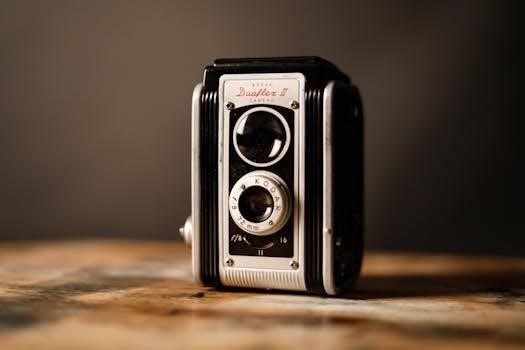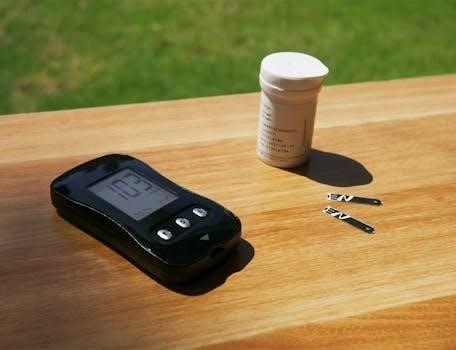
Canon EOS 1300D Manual⁚ A Comprehensive Guide
Welcome to your comprehensive guide for the Canon EOS 1300D! This manual will navigate you through the camera’s features and functionalities. We’ll cover everything from basic controls to advanced shooting techniques, ensuring you get the most out of your DSLR. This guide is designed to help both beginners and enthusiasts alike.
The Canon EOS 1300D, also known as the Rebel T6 in some regions, is an entry-level DSLR camera designed for those new to photography or looking for a reliable and user-friendly option. It serves as a perfect gateway into the world of DSLR photography, offering a blend of simplicity and essential features. This camera is built with an APS-C sensor, providing excellent image quality and allowing for creative depth-of-field effects. The 1300D boasts user-friendly controls, making it easy to learn the basics of photography, while still providing enough manual controls for those wanting to explore further. Its intuitive design and readily available software, drivers and manuals make it accessible for all users, as well as providing support should any issues arise. Whether you’re capturing family moments or experimenting with landscapes, the EOS 1300D is a versatile tool that can handle many photographic situations. It stands out as an excellent entry-level DSLR for beginners with its easy to use design.

Key Features of the EOS 1300D
The Canon EOS 1300D boasts several key features that make it a compelling option for entry-level DSLR users. At its heart is an 18-megapixel APS-C CMOS sensor, which captures detailed images with good dynamic range. It incorporates a DIGIC 4+ image processor, which enhances image quality and helps with quick processing. The camera provides a native ISO range of 100-6400, expandable to 12800, enabling shooting in various lighting conditions. It offers a 9-point autofocus system, which assists in quickly locking onto subjects. The 1300D also features a 3-inch LCD screen, which is handy for reviewing images and navigating the menu. It includes Full HD video recording capability at 30 fps, allowing users to capture smooth and clear videos. The camera also has built-in Wi-Fi connectivity, allowing for easy sharing of photos and remote control via a smartphone. These features combine to make the EOS 1300D a versatile and easy to use camera for beginners.
APS-C Sensor Overview
The Canon EOS 1300D utilizes an APS-C sized sensor, which is a key component influencing image quality. This sensor is physically larger than those found in most smartphones and compact cameras, resulting in improved light sensitivity and dynamic range. The larger sensor area allows each pixel to capture more light, leading to less noise in images, particularly in low-light conditions. The APS-C sensor’s dimensions also contribute to a shallower depth of field, allowing for pleasing background blur, often called bokeh, which is useful for portrait photography. This sensor size provides a good balance between cost and performance, making the EOS 1300D an ideal entry-level DSLR. Furthermore, the APS-C sensor’s crop factor affects the field of view of attached lenses, effectively making telephoto lenses appear longer than they would on a full-frame camera. Understanding the APS-C sensor is crucial to maximizing the potential of the EOS 1300D.
Basic Camera Controls
Understanding the basic controls of your Canon EOS 1300D is essential for capturing great photos. The top of the camera houses the mode dial, allowing you to switch between various shooting modes, such as Auto, Manual, and scene modes. The shutter button, typically located near the grip, is used to take photos, while the power switch turns the camera on and off. On the back of the camera, you’ll find the LCD screen for viewing images and navigating the menu system. The directional buttons allow you to move through menus and settings. The ‘Q’ button provides quick access to commonly used settings, such as ISO, white balance, and picture style. The playback button allows you to review the photos and videos you’ve captured. The menu button leads you to the full range of settings. Understanding each button’s function enables seamless operation and better control over your photography. Familiarizing yourself with these controls will quickly enhance your ability to take the photos you want.
Navigating the Camera Menu
The Canon EOS 1300D’s menu system is your gateway to customizing camera settings and exploring advanced features. To access the menu, press the ‘MENU’ button located on the back of the camera. You will then be presented with several tabs, each containing related options. Use the directional buttons to navigate up, down, left, and right, selecting the different tabs and settings. The ‘SET’ button confirms your selections. The menu is logically organized, with options grouped under categories such as shooting, playback, and setup. Familiarizing yourself with the menu structure will allow you to quickly make adjustments to elements like image quality, white balance, focusing modes, and more. Take your time to explore each tab and its sub-menus, and don’t hesitate to refer back to this guide for clarification. The menu offers a wealth of options that will significantly improve your photography skills. Regular practice with the menu system will make it feel intuitive.
Understanding Shooting Modes
The Canon EOS 1300D offers a variety of shooting modes to cater to different scenarios and skill levels. These modes can be accessed via the mode dial on the top of the camera. The ‘Auto’ mode is fully automatic, ideal for beginners who want the camera to handle all settings. ‘Creative Auto’ allows some manual adjustments while still providing automated assistance. ‘Program’ mode lets you control the ISO, but the camera sets aperture and shutter speed. ‘Shutter Priority’ (Tv) lets you set the shutter speed while the camera adjusts aperture. ‘Aperture Priority’ (Av) lets you set the aperture while the camera adjusts shutter speed. ‘Manual’ mode (M) gives you full control over both aperture and shutter speed. There are also scene modes tailored for specific situations, like portrait, landscape, and sports. Understanding each mode will empower you to take more creative and technically proficient photos. Experiment with different modes to discover their capabilities.

Auto Mode
The ‘Auto’ mode on the Canon EOS 1300D is designed for effortless photography, making it perfect for beginners or quick snapshots. In this mode, the camera automatically analyzes the scene and selects the optimal settings for exposure, focus, and color balance. It handles everything, from choosing the right aperture and shutter speed to adjusting the ISO sensitivity and flash. This allows you to simply point and shoot, without having to worry about technical details. The camera uses its internal algorithms to identify the type of scene, whether it’s a portrait, landscape, or close-up, and adjusts accordingly. While it simplifies the process, it also limits the amount of creative control you have over the final image. Auto mode is ideal for capturing everyday moments where you want speed and convenience. However, it might not always produce the exact results you envision for more artistic shots. For more control, explore other shooting modes.
Manual Mode
Manual mode on the Canon EOS 1300D offers complete creative control over your photography, allowing you to adjust every setting according to your artistic vision. In this mode, you can independently set the aperture, shutter speed, and ISO, giving you full command over the exposure triangle. This is where you’ll truly master the art of photography. Aperture controls the depth of field, enabling you to blur backgrounds or keep everything in sharp focus. Shutter speed dictates how long the sensor is exposed to light, affecting motion blur or freezing action. ISO adjusts the sensitivity of the sensor to light, necessary in low-light conditions but may introduce noise. Manual mode is excellent for learning how each setting impacts your image. It requires a solid understanding of the relationship between aperture, shutter speed, and ISO. With practice, you can achieve exactly the image you envision. This mode is not about being faster, it is about having maximum control over your images.

Image and Video Recording
The Canon EOS 1300D allows for both still image and video recording, offering versatile options for capturing your world. For still images, you can shoot in JPEG or RAW formats, with RAW providing more flexibility in post-processing. The camera supports various image quality settings, allowing you to balance file size and image detail. When recording video, the 1300D provides Full HD 1080p resolution at 30 frames per second, capturing smooth and detailed footage. You can also record at lower resolutions and frame rates for smaller file sizes. The camera includes built-in microphone for audio recording, but an external microphone can be connected for improved sound quality. The 1300D provides easy transitions between still photography and video recording, making it an excellent tool for multimedia creation. Remember to use a tripod for stable video footage and to select the right settings for optimal recording. Experiment with both image and video modes to fully utilize the capabilities of your camera.
Downloading Images and Videos
Transferring your captured images and videos from the Canon EOS 1300D to your computer is a straightforward process. You can connect the camera directly to your computer using a USB cable, which will then appear as a removable drive, allowing you to easily drag and drop your files. Alternatively, you can remove the SD card from the camera and insert it into a card reader connected to your computer. This method often provides faster transfer speeds. Canon also offers software that can be used for importing and managing your photos and videos, providing additional organizational options. Make sure you download the appropriate Canon drivers and software to ensure seamless connectivity and full functionality. Always safely eject the camera or card reader from your computer to prevent data loss. Regularly backing up your files is crucial to avoid losing precious moments. Whether you choose the USB connection or the card reader, the process ensures quick access to your visual content.
Using Canon Software and Drivers
To fully utilize your Canon EOS 1300D, installing the appropriate software and drivers is essential. Canon provides a suite of software tools designed to enhance your workflow. These include applications for image editing, remote camera control, and file management. The drivers ensure smooth communication between your camera and computer, allowing for efficient transfer of photos and videos. You can typically find the latest software and drivers on the official Canon website, specifically tailored for the EOS 1300D. Before connecting your camera to your computer, install the necessary software to avoid compatibility issues. Canon’s software suite often comes with features that simplify the process of organizing and editing your photos, providing a range of functionalities. Ensure that you periodically check for software updates to ensure compatibility with the latest operating systems. Properly installed drivers enable features like remote shooting, enhancing your creative control.
Troubleshooting Common Issues
Encountering issues with your Canon EOS 1300D is sometimes unavoidable, but most problems have straightforward solutions. If your camera isn’t powering on, check that the battery is charged and properly inserted; For image quality problems, verify that the lens is clean and correctly attached. If the camera is not focusing, try switching to manual focus or cleaning the lens contacts. Error messages on the LCD screen can provide clues about the issue; consult the manual for specific error codes. If your images are too dark or bright, adjust the exposure settings accordingly. Software or driver problems may cause connection issues; reinstalling the software can solve these problems. Check the SD card if the camera won’t save photos, ensuring it’s not full. If the camera is not responding, try to reset it. When all else fails, consult the official Canon support website for further guidance.
Where to Find the Official Canon Manual
Locating the official Canon EOS 1300D manual is crucial for fully understanding your camera’s capabilities and troubleshooting effectively. The primary source for the manual is the official Canon website. Navigate to the support section of the Canon website, then search for your specific camera model, the EOS 1300D or the Rebel T6. Here, you’ll find downloadable PDF versions of the user manual in various languages. The manual contains detailed explanations of all the camera’s features and functions and includes troubleshooting guides and specifications. It is essential to download the manual before using the camera to maximize your experience. Canon also provides additional resources like FAQs and software downloads on the same page. You can also find printed versions of the manual available through online retailers and third-party sellers. Always verify that the manual is for the correct camera model.
Exploring Accessories for the EOS 1300D
Enhancing your Canon EOS 1300D experience can be achieved through a variety of accessories. Consider additional lenses to expand your photographic capabilities, such as a telephoto lens for distant subjects or a wide-angle lens for landscapes. External flashes provide better lighting control than the built-in flash, especially in low-light conditions. A sturdy tripod is essential for sharp images, particularly during long exposures or when using heavy lenses. Battery grips can extend shooting time. Protective camera bags and cases are vital for safeguarding your equipment during transport. Lens filters, like UV or polarizing filters, can improve image quality and protect your lens. Remote shutters allow you to capture images without touching the camera. Macro extension tubes are helpful for close-up photography. Memory cards with high capacity and fast write speeds are also essential; These accessories can significantly improve your photography skills with the EOS 1300D.

























